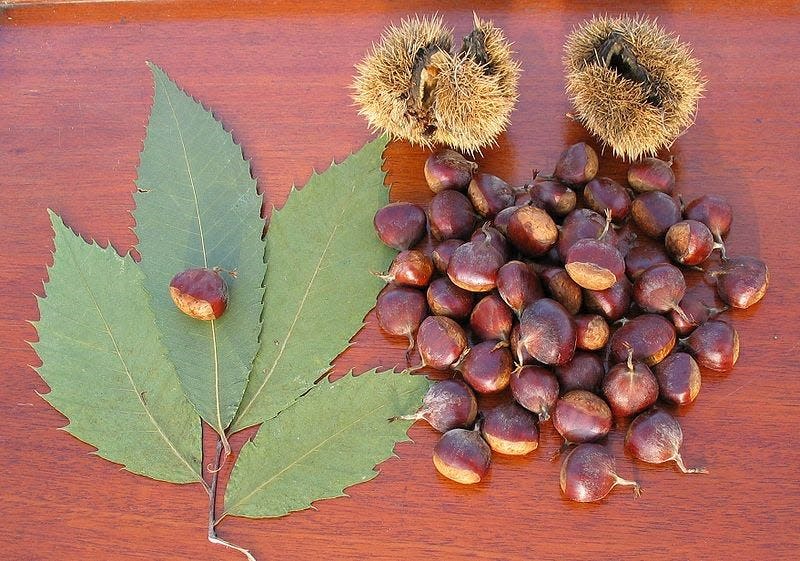Ken Baker: Scientists may be able to restore the American chestnut

Scientists appear to have the technical capability to bring back a tree that we humans had almost driven to extinction — the American chestnut. Should they be given the go-ahead to do so?
In this final essay of a three-part series on the American chestnut, I’d like to focus on a few issues concerning a genetically modified version of the tree that is currently at the heart of many — but not all — people’s hopes for restoring the species to something like its former dominance in the eastern deciduous forests, before our accidental introduction of Chestnut blight fungus from Asia.
More: Baker: The plight of the American Chestnut tree
More: Ken Baker: Examining ways to restore the American chestnut
In 2020, the American Chestnut Research and Restoration Program at the State University of New York-College of Environmental Science and Forestry (SUNY-ESF) in Syracuse, under the direction of Dr. William Powell, submitted a proposal to the U.S. Department of Agriculture to deregulate a genetically engineered American chestnut variety known as Darling 58 for unrestricted planting.

As you might imagine, a lot of energy has been expended on research (and public relations programs) addressing whether it would be a good idea to move forward with a comprehensive restoration program based on such a tree.
The public comment period ending in September 2021 resulted in about 63% favorable responses (34% against, 3% neutral), a virtually unheard of level of support for a genetically modified organism. It’s thought the EPA’s Environmental Impact Statement process and the FDA’s evaluation of possible health issues associated with large-scale planting of the tree should be nearing completion by now. A ruling is expected sometime this year.
As discussed in my last column, this transgenic chestnut has a single gene (nicknamed OxO) from a wheat plant added to its genome which protects it against blight by coding for an enzyme that detoxifies oxalic acid produced by the fungus.
It’s not that the gene makes Darling 58 “immune” to attack by the blight. Rather, by neutralizing one of its main weapons, it provides the tree time to minimize damage caused by the fungus by sealing off and growing around infected areas.
(A) Several points in favor of approving the proposal to deregulate transgenic American chestnuts as put forward by proponents like The American Chestnut Foundation:
The OxO gene is found in a wide variety of plants including many of the fruits and vegetables we commonly eat. The gene was placed within an American chestnut’s genome (on chromosome 7) in a region where studies indicate it has no effect on the tree’s other genes.
None of the tree’s original genes were removed or modified so, unlike Asian chestnut-American chestnut hybrids, Darling 58 has a full complement of American chestnut genes. To get the OxO gene into a wide diversity of American chestnuts, the Darling 58 variant is to be crossbred with many (non-transgenic) trees from across the species’ broad range.
Since only half the offspring from such crosses will have the OxO gene, non-genetically engineered trees will always be produced along with transgenic trees.
Ecological studies have so far found no indication that Darling 58 trees differ from non-transgenic American chestnuts in their uptake of nutrients, allergenic properties, or their interactions with other forest organisms.
The Darling 58 variant has not been, nor will it ever be, patented. This is not a profit-driven commercial enterprise seeking a quick return on investment. In fact, Dr. Powell says, "We call this a century project. To get [the eastern forests] to look even somewhat like it did before the blight is going to take centuries. It's for the next generation — it's planting a tree you'll never enjoy the shade of."
(B) Several points against approving the proposal to deregulate transgenic American chestnuts as put forward by opponents like The Campaign to Stop GE Trees, who warns that:
"The risks of introducing GE [American chestnuts] into forests are numerous and difficult to assess, and regulatory agencies are ill-equipped to evaluate a GE forest tree intended for deliberate spread through wild forests."
Dr. Bernd Heinrich, University of Vermont Emeritus Professor, and others worry that approval of a transgenic chestnut would act as a Trojan horse, serving to seduce the public into accepting other genetically engineered trees — such as extensive plantations of GMO eucalyptus trees — to satisfy the growing demand for pulp and biofuels.
Many view the genetic modification of organisms as an immoral activity, a sign of human arrogance in thinking we can somehow “fix” nature with our technology. North Carolina State University’s Dr. Katie Barnhill-Dilling has pointed out that social scientists have found that increased education tends to solidify rather than shift people’s positions, even in the absence of misinformation. I find that disquieting, but others may see it as reassuring.
One way or another, a decision on deregulation is not far in the offing.
Dr. Evelyn Brister, an environmental ethicist, has observed that restoration ethics involves taking responsibility for repairing harms, preventing future harms, and building a community of care while raising awareness of the potential benefits and risks associated with each restoration option…including doing nothing at all.
Ken Baker is a retired professor of biology and environmental studies. If you have a natural history topic you would like Dr. Baker to consider for an upcoming column, please email your idea to fre-newsdesk@gannett.com.
This article originally appeared on Fremont News-Messenger: Ken Baker: Scientists may be able to restore the American chestnut

